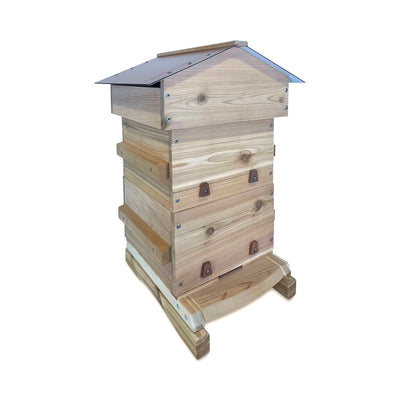Late Summer Beekeeping & Winter Prep
Working with bees in the later part of the summer is a different experience than in the spring time and early summer. Their agenda has shifted from population expansion, comb building and food storage to protecting their assets and preparing for winter. Your response to their needs and behaviors changes as well. Because your bees will very likely become more defensive, be sure to wear appropriate safety gear.
Your hive should be mostly filled with drawn comb and the frames fully occupied with bees. If your bees haven’t filled out all of their available space or there are a lot of unused unoccupied combs, now is a good time to remove unused components. If you are using top bar hives, remove unused bars and utilize the divider board to reduce the cavity size. Langstroth and Warre hives can be reduced by simply removing the unused boxes.Bees can more efficiently and effectively care for a space that they have full command of. If your bees have had an abundance of nectar and there is enough to make a harvest, now is the time to do that. If you aren’t sure how much honey you can safely harvest, check with your local beekeeping association for what is recommended in your region.
You can help your bees prepare their hive for winter now by making sure their bottom board is in good condition and that the lid is rain resistant and insulated. The lid is one of the most important components of the hive. Our Bee Snug All Season Roof is designed specifically to help your bees control their inner hive temperature year round, and has a rain repellent roof.
Another important hive preparation to have in place before winter is mouse guards! Mice love living in beehives. They are warm, have food, and are conveniently located close to the ground for mice to discover. Installing mouse guards will safeguard your bees and your valuable hive equipment from unsanitary mice damage.
Now is also an important time to evaluate the overall health of your colony. As brood production begins to slow down, you can make a guess as to how many full brood cycles are left (21 days) until late fall. Your queen will start laying the eggs of the winter bees soon! As I mentioned in my Brood Frame Basics post, well fed nurse bees raise well fed larva. If your hive is low on food stores now is the time to help them by providing heavy (2:1) syrup and pollen supplements. Your winter bees need to start off as well fed larvae so their nurses need to be well fed, too. The job of a winter bee is not to just work on keeping the cluster warm, they’re the ones that will begin raising the earliest brood in the late winter/early spring, so you can see why their health is especially critical.
By making sure your hive components are winter ready and that your bees have plenty of food to power them through the next stage in their seasonal cycle, you are giving them a solid chance at winter survival.
Leather gloves help to protect your hands during hive inspections.
Your colony should occupy the entirety of their hive.






Leave a comment